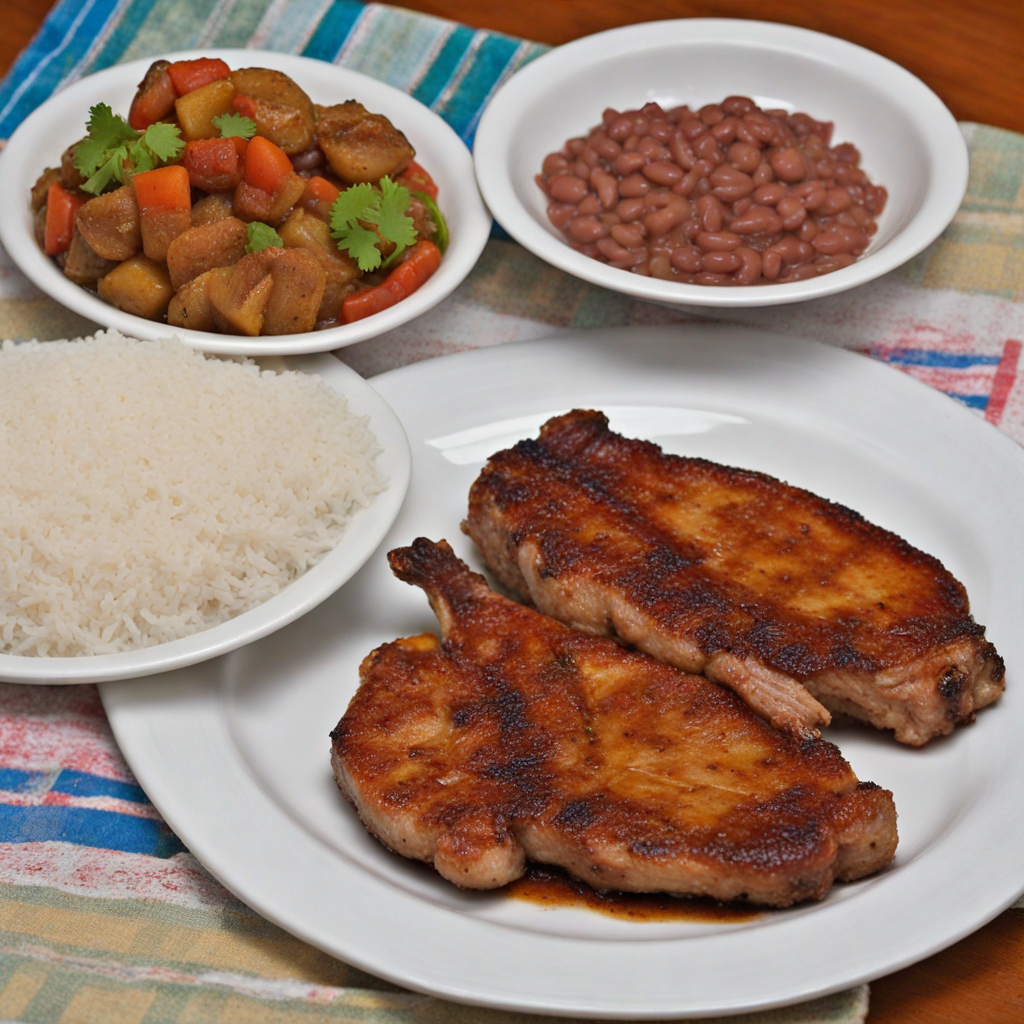Arroz con Leche
Arroz con Leche is a delightful traditional dish from Honduras that embodies the rich flavors and textures characteristic of Central American cuisine. At its core, this dish is a creamy rice pudding made with hand-selected short-grain rice, which absorbs the flavors beautifully. Cooked slowly in a mixture of whole milk and sometimes coconut milk, the rice transforms into a luscious, velvety dessert that is both comforting and indulgent. The addition of sugar creates a sweet balance, making each bite a heavenly experience for your taste buds. To elevate its flavor profile, Arroz con Leche is often infused with aromatic spices such as cinnamon and vanilla. These ingredients not only enhance the dish’s taste but also fill the air with a warm, inviting aroma that beckons you to indulge. Some variations include the use of citrus zest, such as lemon or orange, which adds a delightful brightness that contrasts beautifully with the creamy base. This combination of spices and zest creates a harmonious blend that is truly irresistible. Served warm or chilled, Arroz con Leche is often garnished with a sprinkle of cinnamon powder or a few raisins, adding an appealing visual touch. It’s a dessert that resonates with many, evoking memories of family gatherings and celebrations. Whether enjoyed as a sweet ending to a meal or as a comforting treat on its own, this Honduran classic promises to take your palate on a delightful journey, showcasing the country’s culinary heritage in every spoonful.
How It Became This Dish
Arroz con Leche: A Cultural Journey Through Honduras Arroz con leche, or rice with milk, is a beloved dish that resonates deeply within the culinary landscape of Honduras. While its roots extend across various Latin American countries and even beyond, this creamy, comforting dessert holds a special place in Honduran culture, reflecting the nation's history, agricultural practices, and social customs. Origins and Historical Context The origins of arroz con leche can be traced back to the Spanish colonization of the Americas in the 16th century. The Spaniards brought with them a variety of culinary traditions, including rice cultivation, which they had acquired from their interactions with the Moors in medieval Spain. This combination of rice, sugar, and milk eventually evolved into the dish we know today. In Honduras, indigenous groups such as the Lenca and Garifuna had their own traditional foods, which included local grains and fruits. The introduction of rice, along with the Spanish influence, created a fusion of culinary practices that enriched the local gastronomy. Over time, rice became a staple ingredient in many Honduran dishes, and the adaptation of arroz con leche showcased the ability of the Honduran people to meld different cultural influences into something uniquely theirs. Cultural Significance Arroz con leche transcends mere sustenance; it is a dish imbued with cultural significance and emotional resonance. In Honduras, it is common for families to prepare arroz con leche during festive occasions, religious celebrations, and family gatherings. The preparation of this dish often becomes a communal activity, bringing together family members, young and old, to share in the stirring, seasoning, and savoring of this creamy delight. In many households, the recipe for arroz con leche is passed down through generations, often with unique variations that reflect familial traditions. Some families may add cinnamon, vanilla, or even raisins, while others might incorporate coconut milk or a sprinkle of nutmeg for an extra dimension of flavor. This inheritance of recipes and cooking techniques fosters a sense of identity and belonging, weaving together family histories and cultural narratives. Arroz con leche also plays a role in the everyday life of Hondurans. It is a common dessert served in homes and is often sold by street vendors. The dish's simplicity and affordability make it accessible to people from all walks of life, further embedding it in the everyday culinary practices of the nation. Development Over Time As Honduras has evolved, so too has its culinary landscape. The 20th century saw significant changes in food production and consumption practices, influenced by globalization and migration. With an influx of new ingredients and culinary techniques, traditional dishes, including arroz con leche, began to adapt. The introduction of processed ingredients and convenience foods altered how families prepared meals. While many still cherish the time-honored methods of cooking from scratch, the modern hustle and bustle of life has led some to seek quicker alternatives. Pre-packaged rice pudding mixes and instant milk have emerged, catering to the changing tastes and needs of urban populations. However, the essence of arroz con leche—a dish synonymous with comfort and home—remains intact, often served as a nostalgic reminder of childhood and family gatherings. Moreover, the globalization of culinary practices has led to the emergence of new interpretations of arroz con leche. In recent years, chefs and home cooks have experimented with innovative twists on this traditional dish, incorporating contemporary flavors and techniques. For example, matcha-infused arroz con leche or versions made with almond milk have gained popularity, appealing to health-conscious consumers and those with dietary restrictions. Regional Variations and Influence While Honduras boasts its own distinctive version of arroz con leche, variations exist throughout Central and South America, each with its unique flair. For instance, in Mexico, the dish often includes the addition of sweetened condensed milk and sometimes features a richer, thicker texture. In Peru, arroz con leche may be flavored with cloves and served warm, while in Colombia, it is common to add a touch of panela, a type of unrefined cane sugar. The diversity of these regional interpretations highlights the adaptability of arroz con leche as a dish. It demonstrates how food travels, morphs, and intertwines with local ingredients and tastes while still maintaining its core identity. In Honduras, this adaptability is a testament to the country's vibrant culinary culture, wherein traditional dishes continue to evolve and flourish. Modern-Day Appreciation In contemporary Honduras, arroz con leche enjoys a renaissance as both a traditional and modern dessert. Awareness of food heritage and local culinary practices has grown, with many people seeking to reconnect with their roots through cooking. Culinary workshops and festivals celebrating traditional foods have become popular, often featuring arroz con leche as a star attraction. Social media has played a key role in reviving interest in this dish, with food bloggers and influencers showcasing their renditions of arroz con leche, sharing recipes rooted in family traditions, and experimenting with modern twists. This digital platform has not only helped to keep the dish alive among younger generations but has also connected Hondurans abroad with their culinary heritage. Conclusion Arroz con leche is more than just a dessert; it is a symbol of the rich cultural tapestry that defines Honduras. Its journey from a colonial import to a cherished staple reflects the resilience and creativity of the Honduran people. As families continue to gather around stoves, sharing recipes and stories, arroz con leche remains a warm reminder of home, community, and the enduring power of food to connect us across generations. In a world that is constantly changing, the creamy sweetness of arroz con leche serves as a comforting bridge between the past and the present, ensuring that this beloved dish will continue to be savored for years to come. Through the lens of arroz con leche, we see not just a culinary tradition, but a reflection of the heart and soul of Honduran culture—a culture that celebrates family, history, and the simple joys of sharing a meal.
You may like
Discover local flavors from Honduras







